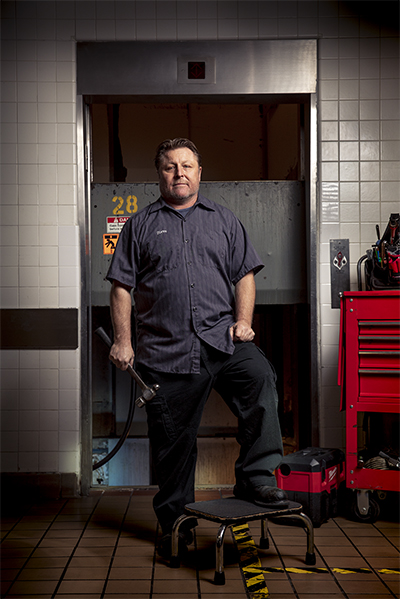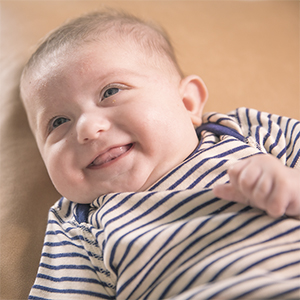Discoveries
Congenital Heart Patients Thrive at Cedars-Sinai
Nov 11, 2021 Cassie Tomlin
Major advances in the field of congenital heart disease have dramatically improved survival rates for babies born within the last 50 years—and outcomes are only improving. But many patients, like Steve Hynes, forgo treatment after they age out of pediatric cardiology, to devastating consequence. Cedars-Sinai’s pioneering congenital heart experts aim to close the treatment gap.

Elevator mechanic Steve Hynes ignored his congenital heart condition for decades, leading to a health crisis.
Steve Hynes and Rafi Perchuk were born about 9 miles and 50 years apart, each with errant veins burdening the beating of their hearts. Across time and space, the boys' mothers suffered the same emotional whiplash when their firstborn sons turned blue in newborn nurseries, shock complicating overwhelming joy.
In 1970, Hynes' parents declined to put their infant through a surgery they were told carried a 50% chance of survival—consequently, over half a century, he deteriorated dangerously into heart failure. But in 2021, faced with a similar condition, Rafi's doctors and nurses at Cedars-Sinai promised his mom that, under their care, her little boy would almost certainly thrive.
The population living with congenital heart disease is more vast and varied than ever before: Babies with defects like Rafi's are born daily, but the majority of patients in the U.S. are adults like Hynes. Even the existence of adult patients is a relatively new phenomenon—as recently as the 1980s, more severe diagnoses resulted in an almost definite death sentence for children. Now, thanks to surgical advances, new generations can survive to adulthood alongside doctors well equipped to treat their unique, lifetime needs. The challenge can be getting those adults to show up for care—a treatment gap that Cedars-Sinai physicians aim to close.
"For the longest time, people thought of congenital heart problems as pediatric issues to be dealt with in childhood, but these conditions have important implications throughout a lifetime," says Evan Zahn, MD, director of the Congenital Heart Program and the Division of Pediatric Cardiology. "You could've had a great heart surgery as a little boy or girl, but when you're 50 and you've developed hypertension, it raises different problems."
The Smidt Heart Institute's Guerin Family Congenital Heart Program is at the forefront of comprehensive care for all patients, from babies diagnosed in the womb to septuagenarians with complex medical histories and new-to-medicine maladies. The expert team, embedded in the largest and most venerated heart program on the West Coast, is uniquely prepared to offer anyone the full spectrum of interventional, open-heart, hybrid and minimally invasive procedures.
Richard Kim, MD, a calm, warm, deeply experienced surgeon, joined Cedars-Sinai in 2020 from Children's Hospital Los Angeles as the new director of Pediatric and Congenital Heart Surgery and surgical director of the Congenital Heart Program. His appointment expanded the program's ability to offer the most advanced surgical options for the most complex cases on both ends of the age spectrum.
In April 2021, on consecutive sunny days, Kim performed lifesaving open-heart surgeries: first on 4-day-old Rafi, and next on Hynes, an adventurous 51-year-old elevator mechanic. Both patients went home within a week, their hearts repaired and open to bright futures.
For the longest time, people thought of congenital heart as pediatric issues to be dealt with in childhood, but these conditions have important implications throughout a lifetime.
Evan Zahn, MD, director of the Congenital Heart Program and the Division of Pediatric Cardiology.
A DIAGNOSIS
Dina Hovsepian's pregnancy with Rafi was healthy and normal, outside of gestational diabetes in her second trimester and despite the COVID-19 pandemic. She had a "magical" delivery at Cedars-Sinai, with her husband and her sister by her side.
Seven hours after Rafi was born, nurses noticed that he looked blue—a sign of lack of oxygen. Before the family could even process his arrival, they had to confront his diagnosis: total anomalous pulmonary venous return (TAPVR), a condition in which four major veins from the lungs drain to the wrong place in the heart, meaning the blood circulating in the body is never fully oxygenated. Without surgery, Rafi would not survive.
Congenital heart disease is the most common birth defect—about 1 in 125 infants enter the world with a malformed vein, artery, valve or heart chamber impeding crucial blood flow. Such structural dysfunctions range from relatively easy-to-fix holes and leaks to complex and life-threatening problems requiring emergency surgery in infancy. Congenital heart disease manifests in so many ways that physicians won't commit to the number of variations. A lot can go wrong as the heart forms from a single cell into a complex, eternally pumping muscle.
"To really get a handle on the field, you have to have seen many patients for many years," Kim says.
Heart anomalies can be inherited but, for most patients, the cause of a congenital defect is unknown. About half of congenital heart diagnoses are considered "simple," like patent ductus arteriosus (PDA), a hole that Zahn fixes with a minimally invasive procedure he developed. The other half are like TAPVR, requiring painstakingly precise repair by a highly experienced surgeon.
THE EXPERT SOLUTION

Rafi Perchuk’s heart condition was repaired and he is thriving, but 50 years ago, the result may not have been so positive.
Despite the distressing, draining news that her baby would need open-heart surgery, Hovsepian was confident in the staff, who "swooned" over Rafi and "did everything they could" to explain his condition and what to expect.
"The nurses took care of Rafi like he was their own baby, and because of how they looked after us as brand-new parents, we could trust the process even more," she says.
On a day of head-spinning firsts for Hovsepian and family, Kim scrubbed in as he has thousands of times before. He opened Rafi's inches-long breastbone to access his strawberry-sized heart. He connected Rafi to a heart-lung machine, which took over the work of those organs. The doctor then cooled Rafi to below 65 degrees to induce hypothermia, so that his cells only needed a minimal amount of oxygen. He slowed Rafi's heartbeat to a stop and rerouted the tiny, misdirected veins to the right place using a suture finer than a human hair. He patched a hole using Rafi's own heart tissue. The repair finished, he rewarmed Rafi's body. Slowly, the infant's heart restarted on its own, and he was disconnected from the machine. The boy recovered well and, four days later, he went home with some Tylenol and instructions for his parents to scoop him up from underneath to protect his healing sternum when holding him.
Rafi and his family received all their care under one roof—from delivery to discharge. And though he is expected to recover fully and enjoy a normal, healthy childhood, he'll need monitoring forever. For Rafi, being born into Cedars-Sinai's program will avoid an all-too-common pitfall for many congenital heart patients: They feel fine when they age out of pediatrics and stop seeing a doctor, only to return years later with accumulated conditions.
"After many of the things we do for children, they will need continuous monitoring," Kim says. "Rafi's problem may be completely solved, but he will still need to be followed for life."
KEEPING PATIENTS CLOSE
In 1970, the year Hynes was born, only 325,000 adults in the United States had congenital heart disease diagnoses. Today, thanks to advances that have radically extended lifespans for such patients, Hynes is one of about 1.3 million. Yet 75% of adults who were born with a congenital heart defect are not under treatment by a specialized cardiologist. Though adult patients live significantly longer when they're cared for by such experts, there are only a tenth as many adult congenital heart physicians as there are pediatric heart doctors.
Cedars-Sinai physicians have the advantage of managing a patient's transition from childhood care to adult care in-house, and they also make it part of their mission to keep patients engaged. The strategy is well-timed transparency, says Ruchira Garg, MD, director of Congenital Noninvasive Cardiology, who is certified in treating both adult and pediatric patients.
"It used to be that once you turned 18 or 20, your pediatric cardiologist couldn't see you anymore, and patients went out into the wild," Garg says. "I start educating teens over a few years so they have a robust understanding of what they're living with and to empower them to be partners in their care."
Without monitoring and guidance, patients often experience slow and steady decline, a consequence of unchecked scarring after procedures, general aging and the collision of acquired heart disease with heart function that's not totally normal at baseline. The preventive approach aims to spare adults from falling ill and requiring repeated procedures.
In addition to screening for diabetes and helping patients control cholesterol and blood pressure, physicians must consider the complex challenges facing adult patients.
"You have to start addressing all these other factors that just aren't there in kids: substance abuse, emotional trauma of living with repeated procedures in childhood, having their own families to support and take care of, maintaining a job," Garg says. "The realities of life come into play."
A DELAYED FIX
Hynes is both a textbook-typical and exceptionally rare adult congenital heart patient: typical because he hadn't seen a cardiologist in years, and rare because not many people of his age with his condition are still alive.
Hynes has partial anomalous pulmonary venous return—similar to Rafi's condition, but less severe, with only two veins draining to the wrong place. Additionally, his heart is on the right side of his chest.
As a kid, his parents took him for regular checkups. His heart function didn't get better or worse, and it didn't keep him from long summer evenings of street hockey in his family's Redondo Beach cul-de-sac or joining the wrestling team in high school.
But left to manage his own healthcare after graduation, he stopped seeing a doctor.
"My life was so normal that I forgot about it," he says.
As a teen, Hynes developed "knucklehead" habits—drinking, smoking, drugs—that persisted into adulthood. He built a good career but also partied a lot—until his heart condition caught up with him in summer 2020, when he had to catch his breath on the way up 15 stairs to his home in Canoga Park, Calif.
An urgent care visit ruled out COVID-19, and he left with antibiotics for what he assumed, at first, was his annual bout of "smoker's cough." But he didn't improve, and in the back of his mind his heart condition lingered. He had good health insurance and knew he should seek an expert opinion.
In June, at his first appointment at the Smidt Heart Institute, Garg immediately began to untangle the situation. Hynes' heart was functioning poorly after a lifetime of extra work and the injury of substance abuse. The right side was enlarged, he had pulmonary hypertension and his heart rhythm was off.
She told him: "This is not your problem to worry about anymore. It's our problem. You're in our hands now."
"Whatever you tell me to do, I'm going to do," he replied.
It started with habits—he quit drinking a fifth of rum a day, changed his diet and stopped smoking. Garg and colleagues put him on "aggressive" heart failure medications, and he underwent a minimally invasive procedure to fix the heart rhythm. Finally, he was ready for more complex surgery.
Kim performed a variation on the process he did with Rafi, this time creating a hole in Hynes' heart and constructing a pathway for the blood in his veins to circulate to the correct side. Five hours later, Hynes woke up.
"You made it," he mused to himself. "Time to recover."
Patients in the 1960s and 1970s were the first brave people to undergo these initial congenital heart disease surgical repairs that have led to improved outcomes. Read more.
THE FUTURE AHEAD
About 15 years ago, Hynes quit his job and drove east for six weeks to Knoxville, Tenn., fishing, camping and golfing along the way. He marveled at the Badlands, where he helped an old cowboy fix up his Jeep. That's the kind of stuff he's looking forward to now—making the second half of his life better than the front end. He feels like he owes it to his heart team.
"I'm finally going to get to live the life I was meant to live," he says.
After two additional procedures, Hynes is back at work. He loves troubleshooting with his union buddies and breathing in the ocean air on his beach city service route. He's easing into hikes in Malibu Canyon and visits to his friend's lake house in San Bernardino County.
Rafi's parents hope that when he reaches Hynes' age, he'll be happy and healthy, accomplished and kind, and that he's well taken care of by physicians who encourage him to stay well.
"What we strive to do is find things before they become big problems," Garg says. "We can intervene along the way and help people live long and full lives."
THE FUTURE OF PERSONALIZED CARE
In their quest to treat patients for life, Congenital Heart Program leaders are studying ways to reduce the need for continued procedures and improve targeted care.
Zahn and a team of biomedical engineers are developing a stent that can grow with a baby—allowing doctors to repair a narrowed pulmonary artery that won’t ever need to be replaced as arteries grow with the body. He expects to start a clinical trial in babies this year.
"The goal is a stent that can be put into a baby as small as a newborn and ultimately enlarged up to a guy my size," he says.
Kim has long been a principal investigator on a National Institute of Health-funded, multicenter study examining genome sequences of children with congenital heart disease. His goal is to use genetic information to personalize care, and he hopes eventually to tailor operations to best suit a patient’s genes.
"We would like to be able to say, based on your genetics, which therapies may be more effective or which medications would work best," Kim says.



